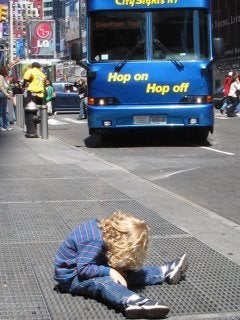
The photograph above clearly shows a bus, headed straight for my child, who is sitting alone in the middle of Times Square. It looks incredibly dangerous and frightening, but in reality, it was neither of those things.
What is not immediately visible in the picture is that my 3-year-old was sitting a good three feet behind concrete barriers designed to protect pedestrians from the traffic on the street.
In addition to his physical distance from the street, both his parents who were standing less than an arms’ reach away were diligently monitoring him. Due to a trick of the camera perspective, what was in actuality a safe place for our son to sit and relax appears to be ominous and threatening when viewed in the photograph.
Perhaps this is often the case in raising children. Most parents would agree that we are responsible for the protection of our children.
What are we protecting them from?
Danger
Pain
Suffering
Failure
Disappointment
As parents we do all we can to protect our children:
We alter the environment to remove all potential for hurt.
We cover corners and install surveillance devices so we can watch and listen if they are out of ear and eye sight.
We remove choke-able items.
We strap them into carriers and seats.
We cover their heads with helmets.
We take them to play on age appropriate structures that have been created to eliminate all potential for danger and damage.
Our intentions are good, but at what cost?
We mean well, but somewhere along the way we have placed so many barriers to learning and development that perhaps we have destroyed any and all potential for our children to take risks within safe spaces.
We must not protect children to the point that we crush their curiosity and their desire to try and to learn new things.
Children need space.
Children need choices.
Children need to try and fail, and then learn to try again.
Children need to explore.
Children need to stretch themselves beyond their current level of accomplishment in order to grow and reach the next level of learning.
What can we do?
How can we, as the caring adults in their lives, provide them with the environment and structure that ensure that they have those things they need while also satisfying our need for their safety?
We know that toddlers cannot learn to walk without trying and falling more than a few times. Picture the adult who walks awkwardly behind a toddling little one, arms outstretched, ready to offer a steadying hand and supportive boost should the child walk to close to a high ledge or sharp corner. The child need never feel the hands of the adult touching them to know that she is safe.
So it is with other learning opportunities in a child’s life. Perhaps it is time to loosen the constraints of protective childhood a bit to give children the space they need. In order to grow into confident, independent young adults, children need to experience opportunities to assert themselves by making choices and learning to live with the consequences of those choices.
Consider expanding the physical space your child has to play. Step back and take a look at your child’s play environment. Think of ways you can give your child a bit more autonomy within her environment. Think about the things you do for your child that your child could possibly do independently with a little guidance and patience. Plan ahead, take the time to teach and practice new skills and take a step back to give your child the time and space to practice the new skill without intervening.
Introduce more choices into your child’s life. Offer two or three options in what to read, what to eat or what to wear. Start with a few possibilities. Choices with too many options feel scary and intimidating. Gradually expand the options over time as your child develops experience and confidence.
As parents, our job is to work our way out of a job, and in order to accomplish this, we must gradually fade into the background. It will be beneficial to our children if we can learn to gradually shift our parameters of protection as our children develop and grow.
This article was originally published on the author’s website, Nurturance.